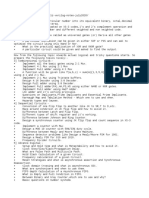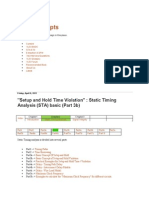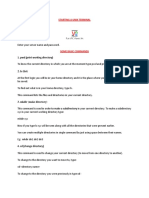0 ratings0% found this document useful (0 votes)
122 viewsUnix Commands
This document provides instructions for connecting to a VPN server using CRSSL client and Putty, and accessing sessions using VNCViewer. It also provides Linux commands for navigating directories, viewing and editing files, searching files, and customizing the terminal environment by creating a .cshrc file.
Uploaded by
Narendra babuCopyright
© © All Rights Reserved
Available Formats
Download as PDF, TXT or read online on Scribd
0 ratings0% found this document useful (0 votes)
122 viewsUnix Commands
This document provides instructions for connecting to a VPN server using CRSSL client and Putty, and accessing sessions using VNCViewer. It also provides Linux commands for navigating directories, viewing and editing files, searching files, and customizing the terminal environment by creating a .cshrc file.
Uploaded by
Narendra babuCopyright
© © All Rights Reserved
Available Formats
Download as PDF, TXT or read online on Scribd
You are on page 1/ 7
1.
CRSSL client -This is required to connect to the Vpn
User id and password will be provided to u
2.Putty is used to connect to the Institute Server
User id and password will be provided – after logging in we will create one
session id .
3.VncViewer -we will use the session id created in putty and we will open the
session here
Note:
Server ip address:10.0.0.20
vncserver -to create a session id
vncserver -list -to list the running session id’s
vncserver -kill :session id number – to kill the session
---------------------------------------------------------------------------------------------------------
---------------------------------------------------------------------------------------------------------
Use the below path to copy dft designs to ur directory
cp -rf ../saddam/DFT_LAB_FEB .
Linux Commands
1) ls - To list all the dir & files
2) ls -d */ - To list only the directories
3) ls -f */ - To list only the files
4) ls *.v - To list only the req format files
5) ls -a -To list the hidden files
6) ls * - To list all files under the corresponding dir’s
7) file * - to display all empty files
8) ls -lrt – To list the history of the all files
9) ls -lrt file or dir name -to know tha history of the particular file or dir
10) cd - to change from one dir to another directory
11) uniq filename - to delete continuos repeated line
12) touch filename – To create a empty file
13) touch .filename – To create a hidden file
14) gvim filename -To open a file
15) gvim file1 file2 -d - to diff the 2 files
16) gvim file1 file2 -o - to split open the 2 files
17) cat or vi filename -To open the files in the current window
18) cat file1 file2 > file3 - to merge file1 & file2 data to file3
19) tac filename - to display the lines of a file in reverse order
20) pwd -To show the present working directory
21) mkdir dir name -to create a dir
22) mkdir -v dir name -To create a dir and to give created info
23) mkdir -p dir1/dir2/dir3 -To create sub dir’s
24) mkdir -v dir name ; ls -to create the dir and list all files
25) cp source path destination path -to copy the files
26) cp -rf source path destination path -to copy the directories
27) cp source path . -to copy the files to the current dir
28) cp -rf source path . -to copy the dir to the current dir
29) rm filename -To remove the files
30) rm * - to remove all files
31) rm -rf dir name -to delete dir
32) rm -rf * -To delete all dir’s
33) mv old filename new filename - to rename a file or dir
34) mv source destination - to move the files and dir
35) du -sh filename -to know the size of the file
36) df -kh . – to know the disk space
37) wc filename -to know the total lines and total words and total
characters of file
38) we have analysed permissions for user group others
Ex:drwxrwxrwx
39) u -primary user g- group o-others
40) chmod 700 file/dir name -to disable all permissions for group and
others
41) chmod 777 file/dir name -to enable all permissions for user
,group and others
42) chmod o-rw file/dir name -to remove the read and write
permissions for others
43) chmod g+rw file/dir name -to add the read and write permissions
for group
44) hold the cntl & shft buttons and press + in the keyboard to
increase the font size of the terminal
45) hold the cntl button and press - in the keyboard to decrease the
font size
46) yy- To copy a line in the file
47) p- to paste a line in the file
48) dd-to delete a line in the file
49) :w-to save a file
50) :q- to quit the file
51) :x-to save and quit a file
52) :%s:oldword/newword:gc - replace the words in a file
53) History - To know history of the work done
54) !history number - to excute the command
55) Shift d -to delete data right side of the cursor
56) d&0 -to delete the data left side of the cursor
57) :se nu -to display line numbers
58) :se nonu -to remove the line numbers
59) Shift * -to highlight a word
60) :noh -to unhighlight the search word
61) :se hlsearch -to highlight the last highlighted word
62) gg -to goto 1st line of the file
63) Shift g - to goto last line of the file
64) head -10 filename - to display top 10 lines of a file
65) tail -5 filename - to display last 5 lines of a file
66) gzip filename - to zip a file
67) gunzip filename - to unzip a file
68) :linenumber - to just to the req line
69) /searchword - to search for the search word in file from top
70) ?searchword - to search for the search word in file from bottom
71) i -to enter into insert mode in a file
72) Control c - to terminate the ongoing run
73) Escape -to enter into escape mode in a file
74) :se wrap -to make big lines into multiple lines in file
75) :se nowrap -to make multiple lines into a single line in file
76) Home -to goto the starting of the line
77) End -to go to end of the line
78) :g;;d -to delete all highlighted lines in file
79) :v;;d -to delete all unhighlighted lines in file
80) Shift+v - to select a line in a file
81) Shift+v & shift+g to select all lines in a file
82) Delete-to delete the selected lines in a file
83) Control+v & shift+g &shift+i &escape -to add the required data in
all the lines
84) grep -r searchword filename -to search for the req word in the
entire file
85) grep -ir searchword filename -to search for the req word in the
entire file irrespective of case sensitive
86) grep -irv searchword filename -to display the all lines other than
searchword in the entire file irrespective of case sensitive
87) grep -r searchword - to display searchword lines in all the files of
current dir
88) grep -ir searchword - to display searchword lines in all the files of
current dir irrespective of case sensitive
89) grep -irv searchword - to display other lines except searchword in
all the files of current dir
90) grep -o searchword filename - to display only the searchword in
the file
91) grep -io searchword filename - to display only the searchword in
the file irrespective of case sensitive
92) grep -in searchword filename - to display the searchword lines in
the file and their position numbers
93) grep -il searchword * - to display all files which is having the
searchword in the current dir
94) grep -ic searchword filename -to display total count of the
searchword in the file
95) grep -im3 searchword filename - to display the 1st 3 search
results
96) grep -iv searchword filename - to display the lines other than
the searchword
97) grep -x “word1 word2” filename - to search 2 words at atime in a
file
98) grep searchword filename > new filename - to save the search
results into a new file
99) grep searchword filename >> oldfilename - to save the search
results into a oldfile without deleting the previous data
100) sed '/^ /d' filename -i - to delete the lines which starts with
space
101) sed '/;/d' filename -i - to delete the lines which ends with the ;
102) sed 's/oldword/newword/g' filename -i - ro replace the word
with new word
103) sed '/searchword/d' filename -i - to delete the lines which is
having the searchword
104) sed '/^vlsiguru/d' filename -i - to delete the lines which starts
with word vlsiguru
105) sed '/vlsiguru$/d' filename -i - to delete the lines which ends with
the word vlsiguru
106) sed '/print.*resistor/d' filename -i - to delete the lines which
starts with the word print and ends with the word resistor
107) sed 's/#.*//' filename -i - to delete the lines which starts with #
108) sed '/banglore/d;/^$/d' filename -i - to delete the lines having
the word banglore and to delete the empty lines
109) sed '/banglore$/d;/^$/d' empty -i -to delete the lines ends with
the word banglore and to delete the empty lines
110) sed '/^banglore/d;/^$/d' empty -i -to delete the lines starts with
the word banglore and to delete the empty lines
Create a .cshrc file in ur directory and Paste this below lines into .cshrc file
and save it
set complete=enhance
alias g gvim
alias s source
alias rf readlink -f
alias c clear
alias h history
alias e exit
source /home/tools/mentor/cshrc_mentor
source /home/tools/synopsys/cshrc_synopsys
You might also like
- Synopsys VCS Commands For Verilogn CompilationNo ratings yetSynopsys VCS Commands For Verilogn Compilation3 pages
- What Are The Differences Between SIMULATION and SYNTHESISNo ratings yetWhat Are The Differences Between SIMULATION and SYNTHESIS12 pages
- Is Hold Always Checked On The Same Edge - PDFNo ratings yetIs Hold Always Checked On The Same Edge - PDF3 pages
- Setup and Hold Time Violation Static Timing Analysis (STA) Basic (Part 3b) VLSI ConceptsNo ratings yetSetup and Hold Time Violation Static Timing Analysis (STA) Basic (Part 3b) VLSI Concepts14 pages
- Digital VLSI Design Lecture 3: Logic Synthesis: Semester A, 2018-19 Lecturer: Dr. Adam TemanNo ratings yetDigital VLSI Design Lecture 3: Logic Synthesis: Semester A, 2018-19 Lecturer: Dr. Adam Teman47 pages
- Verification Is The Process of Checking The Design Against The GivenNo ratings yetVerification Is The Process of Checking The Design Against The Given18 pages
- Examples of Setup and Hold Time - Static Timing Analysis (STA) Basic (Part 3c) - VLSI ConceptsNo ratings yetExamples of Setup and Hold Time - Static Timing Analysis (STA) Basic (Part 3c) - VLSI Concepts7 pages
- How To Automate Millions Lines of Top-Level UVM Testbench and Handle Huge Register ClassesNo ratings yetHow To Automate Millions Lines of Top-Level UVM Testbench and Handle Huge Register Classes3 pages
- Vlsi/Fpga Design and Test CAD Tool Flow in Mentor GraphicsNo ratings yetVlsi/Fpga Design and Test CAD Tool Flow in Mentor Graphics20 pages
- Verdi-Static Debug: Team Members: 1. Anurag Upadyay (40018035) 2. Laxmipriya (40018047) 3. Mohan Varma K (40018045)No ratings yetVerdi-Static Debug: Team Members: 1. Anurag Upadyay (40018035) 2. Laxmipriya (40018047) 3. Mohan Varma K (40018045)12 pages
- Application-Specific Integrated Circuit ASIC A Complete GuideFrom EverandApplication-Specific Integrated Circuit ASIC A Complete GuideNo ratings yet
- Files:: Ls Ls - L Ls - A Esc K More FilenameNo ratings yetFiles:: Ls Ls - L Ls - A Esc K More Filename9 pages
- PWD (Print Working Directory) : Starting A Unix TerminalNo ratings yetPWD (Print Working Directory) : Starting A Unix Terminal7 pages
- Sagar Institute of Science & Technology Question BankNo ratings yetSagar Institute of Science & Technology Question Bank5 pages
- The Segmentation of Oral Cancer MRI Images Using Residual NetworkNo ratings yetThe Segmentation of Oral Cancer MRI Images Using Residual Network8 pages
- Spotify Premium v8.9.96.476 MOD APK (Final, Unlocked, Amoled) DownloadNo ratings yetSpotify Premium v8.9.96.476 MOD APK (Final, Unlocked, Amoled) Download3 pages
- CHAPTER 5 Project Management and Resource AllocationNo ratings yetCHAPTER 5 Project Management and Resource Allocation34 pages
- Software Process and Agile Practices Course NotesNo ratings yetSoftware Process and Agile Practices Course Notes64 pages
- Specifications WD 230 Manual Doouble DoorNo ratings yetSpecifications WD 230 Manual Doouble Door3 pages
- Data Structures and Algorithms LAB Assignment-1 Register Number: 20BCE2285 Name: Namish DevarajNo ratings yetData Structures and Algorithms LAB Assignment-1 Register Number: 20BCE2285 Name: Namish Devaraj33 pages
- VMware vSphere 7 Design Supplemental SlidesNo ratings yetVMware vSphere 7 Design Supplemental Slides18 pages
- Cloud Computing of E-Commerce: Technical Seminar OnNo ratings yetCloud Computing of E-Commerce: Technical Seminar On17 pages

























































































